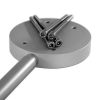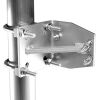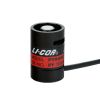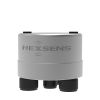Kipp & Zonen SMP Series Smart Pyranometers
Features
- Internal digital signal processing and interfaces for industrial applications
- Automatic correction for temperature dependence of the detector sensitivity
- Built-in bubble levels and adjustable leveling feet
- Expedited repair and warranty service
- Lifetime technical support
- More
Overview
The Kipp & Zonen SMP Series Smart Pyranometers are high-quality radiometers designed for measuring short-wave irradiance on a plane surface (radiant flux, W/m²), which results from the sum of the direct solar radiation and the diffuse sky radiation incident from the hemisphere above the instrument.
Integration
SMP pyranometers feature internal digital signal processing and interfaces optimized for industrial data acquisition and control systems. Kipp & Zonen has developed a smart interface that features RS-485 Modbus data communication for connection to programmable logic controllers (PLC’s), inverters, digital control equipment and the latest generation of data loggers. Amplified Voltage or Current outputs are also included for devices that have high-level analog inputs or current loop interfaces.
Model Options
All models are available in two versions. One has an analog voltage output of 0 to 1 V, and the other has an analog current output of 4 to 20 mA. They all have a 2-wire RS-485 interface with Modbus (RTU) protocol. Digital signal processing provides faster response times and, with an integrated temperature sensor, corrects for the temperature dependence of the detector sensitivity.
Design
To achieve the required spectral and directional characteristics, SMP Series pyranometers use thermopile detectors and glass domes. All SMPs have built-in bubble levels and adjustable leveling feet. Snap-on sun shields reduce solar heating of the housings. The waterproof connectors have gold-plated contacts.
In The News
Monitoring Mariculture in the Gulf of Alaska
The mariculture industry in the Gulf of Alaska has been steadily growing in recent years, guided by ongoing research to help refine farm location and cultivation practices. A subset of aquaculture, mariculture focuses on rearing organisms in the open ocean. In Alaska, finfish farming is illegal, so most farms cultivate kelp, oysters, or a combination of the two. These small, locally operated farms started popping up in the Gulf of Alaska in the early 1990s, when shellfish farming first became legal. Kelp farming did not begin to catch on in the state until 2016. Many of the coastal areas that have grown interested in mariculture are historically commercial fishing communities.
Read MoreSupplying Seattle’s Drinking Water: Using Data Buoys to Monitor the Cedar River Municipal Watershed
Providing clean, safe, and reliable drinking water for the 1.6 million people in the greater Seattle area is a top priority for Seattle Public Utilities (SPU). With limited water supplies, SPU dedicates considerable resources to maintain its watersheds and mountain reservoirs. About 70 percent of Seattle Water comes from the Cedar River Municipal Watershed , and the other 30 percent comes from the South Fork Tolt River Watershed . [caption id="attachment_39574" align="alignnone" width="940"] Data buoy in Chester Morse Lake . (Credit: Kevin Johnson / Seattle Public Utilities) [/caption] Jamie Thompson, a fisheries biologist at SPU, monitors aquatic ecosystems centered on fish listed under the U.S. Endangered Species Act (ESA).
Read MoreData-Driven Advocacy on the Lower Deschutes River
Like many freshwater environments, the Deschutes River in Oregon is under pressure from development, pollution, and climate change. Many rivers, streams and lakes in the Deschutes Basin do not meet Oregon water quality standards –where state water quality monitoring assesses levels of bacteria, pH, dissolved oxygen, temperature, and fine sediment. Hannah Camel is the Water Quality Coordinator for the Deschutes River Alliance (DRA), a non-profit organization that focuses on the health of the lower 100 miles of the Deschutes River–the area most affected by human intervention. As a data-driven organization, the DRA has benefited from the installation of two NexSens X2 data loggers.
Read More
























